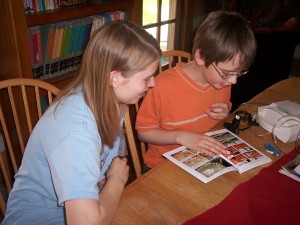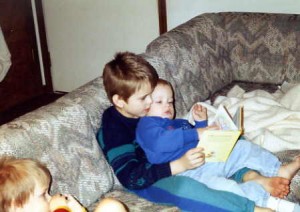Linda Asks:
I saw that you said, in several places, that it is a bad idea to have right-brained kids read aloud, and that reading aloud is a “left-brained” approach. It seems to me that nothing could be further from the truth! The left-brained approach is all silent reading! It’s what they make the kids do in school these days! Words on a a page have no emotion, no drama, no life! If you never read aloud, you never give voice, emotion, and expression to the words!
In aboriginal tribal cultures, storytelling was a highly valued art. I have heard that some Native Americans objected to writing down stories because doing so detached the story from the storyteller. Storytelling involves theater and emotion – right-brained attributes!
It seems obvious that NOT reading aloud takes away some of the impact of fiction. But this applies to fact/information, too. Don’t most right-brained students (in fact, most people, in general) learn a lot better from listening to an interesting, animated, (and preferably humorous) teacher/lecturer, or from a play/TV show/movie/video than from a dry textbook?
Does not taking oral expression/drama out of reading remove ALL of the right-brain aspects of the communication from the words? Isn’t it like taking the melody out of every song?
I reply:
During the “learning to read” phase of the reading process, a right-brained child typically starts out by reading the bigger, easier to visualize words and then filling in the smaller words. When reading aloud, a right-brained child can’t skip the smaller, not easily visualized words, and so it slows down their natural process to learning to read.
The other thing a right-brained child typically does when he’s learning to read is translates the words to a visual. They only need to capture “enough” words to do so, often taking in whole chunks of words, some have even said they can take in entire paragraphs! (boggles my mind) and captures the visual. By making a young right-brained reader read aloud, you are preventing them from taking in and converting larger chunks of words into pictures, which is the core of their comprehension ability. Without comprehension and enjoyment, what’s the point of reading?
Because left-brained young children are part to whole learners, reading aloud and learning to read by one word at a time through the read aloud process doesn’t infringe on their natural learning to read process.
When a beginning reader, a right-brained child can’t read aloud fast enough for enjoyment. Once fluency is achieved for a right-brained reader, she may enjoy reading aloud.
 Storytelling is not the same as reading aloud. My daughter happened to be here, so I asked her what she prefers, reading silently or out loud? She said silently, and I asked why? She said that you are right, Linda. Emotion and feeling and bringing it all alive is extremely important in reading to her. And she much prefers her own interpretation and creation of the words. She said that the words are merely the symbol to represent the emotion, feeling and experience. She translates the word in the way that is most interesting and exciting for her. Right-brained readers enjoy reading because it is a translated creation in their own minds of the words. I’ve always wished I could experience the visuals and “real worlds” they create in their minds from reading. They live it! I find that fascinating and amazing.
Storytelling is not the same as reading aloud. My daughter happened to be here, so I asked her what she prefers, reading silently or out loud? She said silently, and I asked why? She said that you are right, Linda. Emotion and feeling and bringing it all alive is extremely important in reading to her. And she much prefers her own interpretation and creation of the words. She said that the words are merely the symbol to represent the emotion, feeling and experience. She translates the word in the way that is most interesting and exciting for her. Right-brained readers enjoy reading because it is a translated creation in their own minds of the words. I’ve always wished I could experience the visuals and “real worlds” they create in their minds from reading. They live it! I find that fascinating and amazing.
When others read aloud or even when she hears a gifted storyteller, she said it’s not that she doesn’t enjoy it, because she does. But she prefers her own interpretation best. She then becomes the co-creator of the story instead of relying on the author’s or storyteller’s interpretation only. She said hearing words just feels differently to her than translating the words in her own mind.
All of that said, I’ve always said that it’s a VERY important part of a  right-brained child’s life to have read-alouds and audio books in their lives. I believe these are the first “mentors” for them in learning to read. How is that? Between 5 and 7 years old, right-brained children are developing their visualization skills. It’s not like visualization skills are already fully ripened and honed for them any more than translating symbols is ripened or honed for left-brainers. We need practice and exposure. So read-alouds and audio books give that visualization practice for right-brained children. They learn to take the spoken word and translate it into their own images and creations.
right-brained child’s life to have read-alouds and audio books in their lives. I believe these are the first “mentors” for them in learning to read. How is that? Between 5 and 7 years old, right-brained children are developing their visualization skills. It’s not like visualization skills are already fully ripened and honed for them any more than translating symbols is ripened or honed for left-brainers. We need practice and exposure. So read-alouds and audio books give that visualization practice for right-brained children. They learn to take the spoken word and translate it into their own images and creations.
When they’re ready to take on the “input” side of things by decoding words in order to be translated/visualized, there is a temporary “slow down” of their ability to translate/visualize/enjoy the story as they get competent at the decoding part. Silent reading helps them speed that process along. Having a parent read aloud one of the books in a series helps them speed that process along because they already have the visual/translation part of the story done, so they can concentrate on the decoding part. That’s why it’s actually still important to read aloud to a right-brained child learning to read; they can still get to enjoy a story while they figure this decoding part out.
And they have to get used to how it “feels” to decode, translate, and visualize instead of just translate and visualize with read alouds. A type of resource right-brained children may choose to help them during this stage is highly visual material like comic books, manga, magazines, and graphic novels because the visual is already translated for them. Another strategy that may be used is something a friend of mine mentioned. Her son was still heavily using audio books even after he learned to read because it was more enjoyable for him because it took a while for him to have an efficient decode to translation to visualization process. Audio books were more direct for him. You can compare it to going from picture books for small children to chapter books with no pictures. At first, a small child misses  the picture books and still looks at them a lot during the transition, but eventually, they get competent enough with their listening skills and imagery skills to enjoy a chapter book without pictures.
the picture books and still looks at them a lot during the transition, but eventually, they get competent enough with their listening skills and imagery skills to enjoy a chapter book without pictures.
Silent reading and reading aloud can be enjoyed by all people; left- and right-brained people. But there are preferred methods of input, and there are preferred “learning to read” processes that support the natural process of both a left- and right-brained child learning to read. Silent reading is better for right-brained early readers and left-brained early readers can enjoy the reading aloud process. It’s more fun for me to read aloud because I like to share enjoyment of what I read as an extrovert. Plus, more importantly, I figured out that I need to see the words to enjoy a read aloud. So being the read aloud person is ideal for me. It is extremely difficult for me to concentrate on a read aloud. I can’t be doing anything else but focused listening. It was an interesting realization I had about myself as I’ve written my book and shared what I’ve learned with others.
Caroline shares her personal experience as a right-brained person:
I can hardly stand reading aloud (to be the one reading aloud or hearing it); it can’t happen fast enough to hold my attention. When I read silently, I definitely “see a movie” in my head. Often I assign pronunciations to words, especially made up or unfamiliar nouns that probably have nothing to do with the authors plan. I don’t care what the name is or how it is supposed to be pronounced, I want to find out what it does or “means.” While vocabulary helps you express ideas better and faster to others, I find internally it slows down my thinking in pictures, having to translate the visual into a word and back.
Which leads to an interesting idea… When I make pictures in my head from a book or lecture, the “movie” is my own creation, led by the outside ideas to the extent I allow that, but also may have additional information added based on my own experience. When asked to parrot back information, you are forcing someone to understand and communicate in a predetermined format that may be contrary to their perceptions.
It is a reasonable request, to learn to listen or read and give back an answer that mirrors the content as the author attempts to express it. But internally all of us add conclusions based on our own experience.
I think the goal of pleasure reading is to support the movie in your head. If an author gives you a “good show” you will want to read more of what they write, what you see or how accurately it represents what the author intended is irrelevant. For some the “sound” the words convey is an important part of the pleasure, for others it is not. There is no “correct” or “wrong” way to read for pleasure. It doesn’t matter if you only read the first sentence in every page, as long as it works in your own head to tell the story. I suspect those who do not enjoy reading were forced to do it a certain way during an important part of their development that was more distracting than enhancing for them.
A reader shares about her right-brained daughter:
My daughter did not LIKE the way I read aloud, not dramatic or expressive enough, not the way she heard it in her head. She learned to read herself, because of that, at 7. She LOVED the Babysitter’s little sister books and could not STAND how I was mangling them.
She tells me she reads by whole word or even whole sentence now, NOT sequentially or phonetically but by how the word LOOKS. (She says this is why she’s good at spelling; she sees the word in her head and if its misspelled it doesn’t LOOK right.) I didn’t know this then, but now that I know enough to ask her about all this, that’s how she explains it. But she was a determined little pup!
And good heavens she is an INCREDIBLE reader out loud now, so much emotion and expression, she is in demand for reading to little kids, reader’s theater, and at our buddhist family group retreats…. Her standards are way higher than mine.
Holly asks for advice about her right-brained son:
Does anyone have any information on right brain learners and speed reading? My son is turning 8 in a few weeks and has really taken to a book, but it’s a 5th grade level book so there are lots of words that he has never seen. He seems to be able to read the larger words but mixes up the smaller words like (I, a, he). He seems to want to read fast because the faster he reads, the better fluency he has and less mistakes, but he is new to reading especially at this level so sometimes he has to slow down to get the meaning. He picked this book to read and it has shown him that you can read because you enjoy it which is a first for him and I really don’t think it’s too hard for him because he isn’t frustrated by it and doesn’t miss a lot of words. I’m just wondering if reading faster would be beneficial to him. I don’t want to tell him to read faster because he might think that I think he is reading too slowly, but I’m wondering is there a way to “teach” speed reading and is it beneficial to right brainers?
I replied:
First, your son is reading exactly how he is meant to read as a right-brained reader. It’s really exciting! Don’t worry about teaching speed reading or whatever, because he’ll pick that up naturally because that is how many right-brained people read. Do stop having him read aloud and have him read silently. That will take him the furthest in his reading progression. What can you do to know how he’s doing? Ask him about what he’s reading. If he can tell you, then he’s getting it. Give him the space to work out these right-brained reading early differences without spotlighting them, and they’ll disappear on their own time.
I find it interesting that you were able to share typical right-brained early learning reading traits and not know it … skipping small words, having better fluency the faster he reads, having to slow down to get the meaning from time to time if he hits some rough patches, and picking high interest books “above his level” of reading. It means he’s doing fantastic all by himself! Enjoy 🙂
Holly writes back with an update:
It works! I am having him read a chapter book right now silently and then we discuss what is going on in the book so that I know he is comprehending. He went from reading 15 pages out loud to reading 40 pages silently with complete comprehension of what is going on in the book–amazing recall actually–could tell me some things exactly as they were written in the book. This will definitely take him to a whole new level in reading. Thanks for the advice and suppport!
Question: What do you prefer: reading aloud or silent reading, and why? What do you notice your children prefer: reading aloud or silent reading, and in what instances? I look forward to hearing your answers!






Pingback: Promoting a Positive Relationship with Print | The Right Side of Normal
Pingback: Learning to Read with Sight Words | The Right Side of Normal
Pingback: All About Spelling | The Right Side of Normal
Pingback: An Introduction to the Creative Right-Brained Learner | The Right Side of Normal
Pingback: Learning to Read with Sight Words | The Right Side of Normal